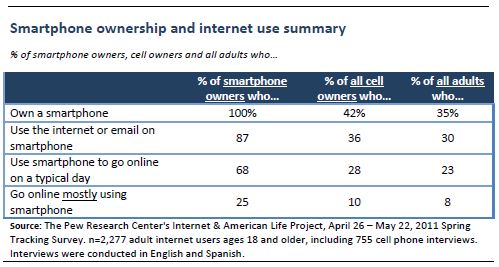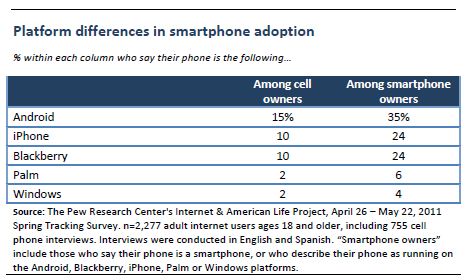In its first standalone measure of smartphone ownership, the Pew Internet Project finds that one third of American adults – 35% – own smartphones. The Project’s May survey found that 83% of US adults have a cell phone of some kind, and that 42% of them own a smartphone. That translates into 35% of all adults. Our definition of a smartphone owner includes anyone who falls into either of the following two categories:
- One-third of cell owners (33%) say that their phone is a smartphone.
- Two in five cell owners (39%) say that their phone operates on a smartphone platform (these include iPhones and Blackberry devices, as well as phones running the Android, Windows or Palm operating systems).
And here’s how they feel about their devices:

Smartphone adoption is highest among the affluent and well-educated, the (relatively) young, and non-whites
Several groups have higher than average levels of smartphone adoption, including:
- The financially well-off and well-educated – 59% of adults living in a household earning income of $75,000 or more are smartphone owners; 48% of those with a college degree own smartphones.
- Those under the age of 45 – 58% of Americans between the ages of 25 and 34 now own a smartphone as do 49% of those ages 18-24 and 44% of those ages 35-44. Even among those with a household income of $30,000 or less, smartphone ownership rates for those ages 18-29 are equal to the national average.
- African-Americans and Latinos – 44% of blacks and Latinos are smartphone users.
Urban and suburban residents are roughly twice as likely to own a smartphone as those living in rural areas, and employment status is also strongly correlated with smartphone ownership.
Mobile phones are a main source of internet access for one-quarter of the smartphone population
Some 87% of smartphone owners access the internet or email on their handheld, including two-thirds (68%) who do so on a typical day. When asked what device they normally use to access the internet, 25% of smartphone owners say that they mostly go online using their phone, rather than with a computer. While many of these individuals have other sources of online access at home, roughly one third of these “cell mostly” internet users lack a high-speed home broadband connection.
Smartphone owners under the age of 30, non-white smartphone users, and smartphone owners with relatively low income and education levels are particularly likely to say that they mostly go online using their phones.
Android is the most common smartphone platform, followed by iPhone and Blackberry devices
Phones operating on the Android platform are currently the most prevalent type of smartphone, followed by iPhones and Blackberry devices.
Demographically, Android phones are especially common among young adults and African-Americans, while iPhones and Blackberry devices are most prevalent among college graduates and the financially well-off.
About this survey
The results reported here are based on a national telephone survey of 2,277 adults conducted April 26-May 22, 2011. 1,522 interviews were conducted by landline phone, and 755 interviews were conducted by cell phone. Interviews were conducted in both English and Spanish. For results based on all adults, the margin of error is +/-2 percentage points; for results based on all cell owners, the margin of error is +/-3 percentage points (n=1,194); and for results based on smartphone owners, the margin of error is +/-4.5 percentage points (n=688).






